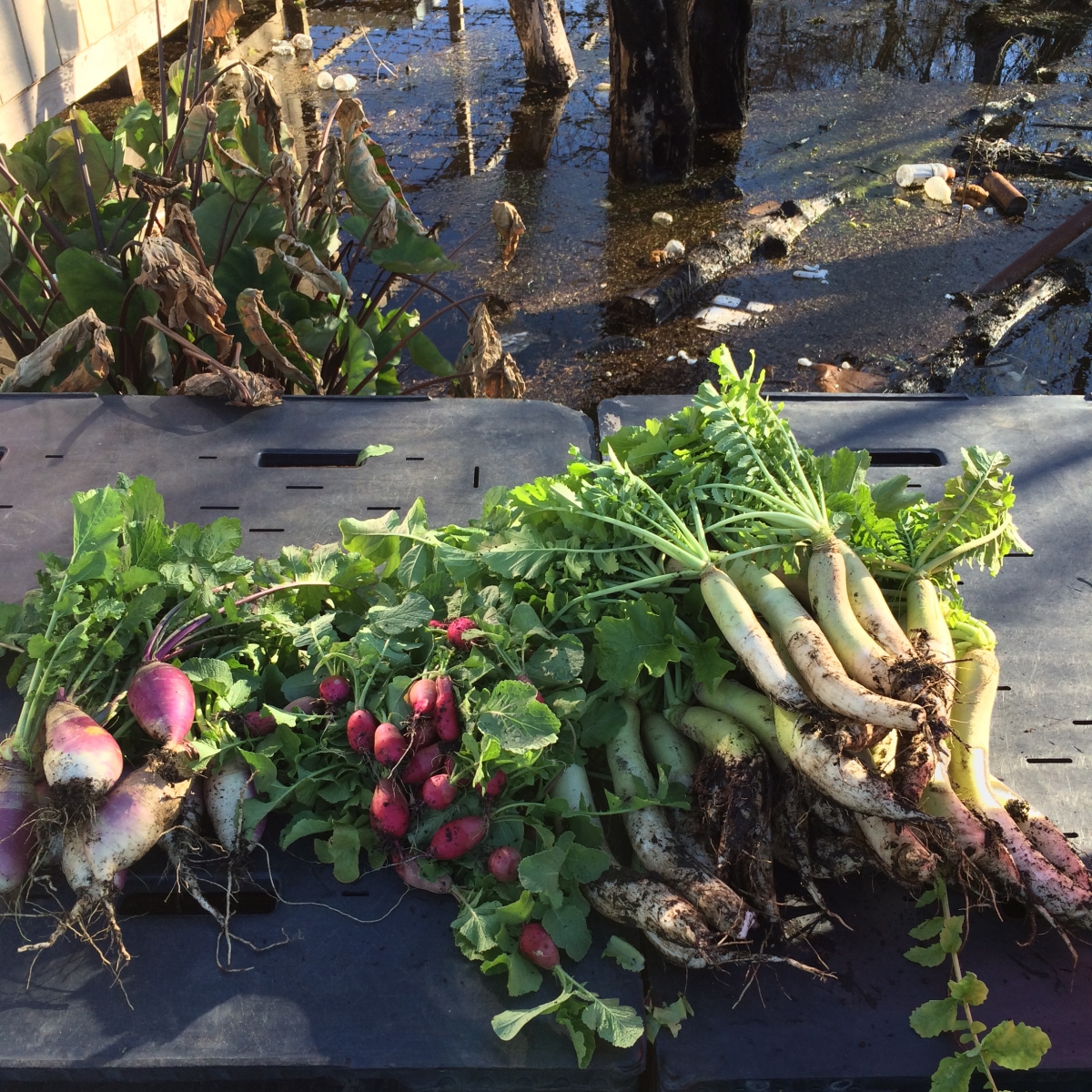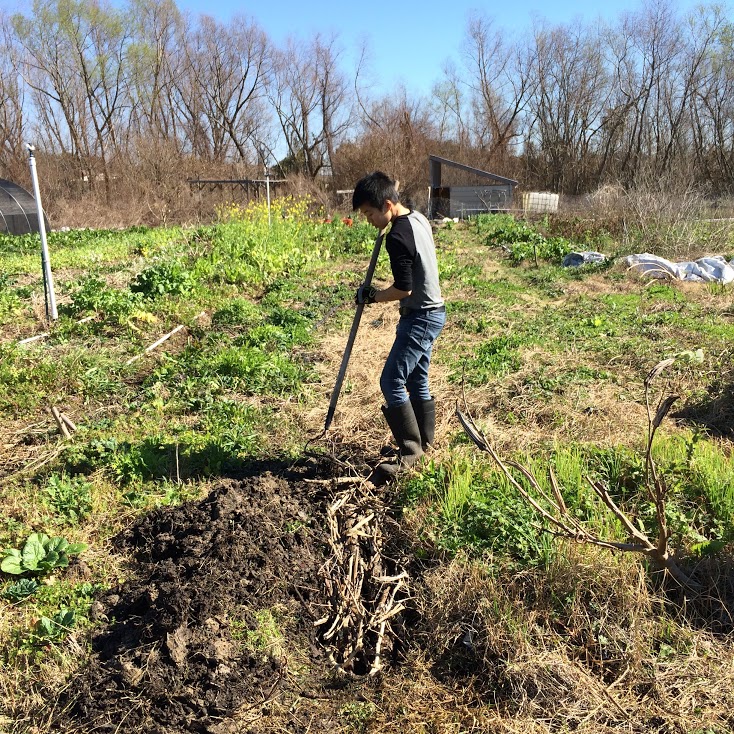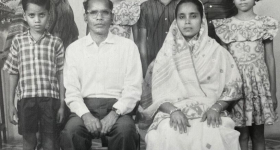Disaster has changed the way many New Orleanians think of their place in the city. For residents of Versailles, where many of New Orleans’ Vietnamese and Vietnamese Americans live, these disasters — from hurricanes to oil spills — have put a spotlight on government failure. Residents continue to face an absence of fresh food, social services, and industrial pollution. But one group of farmers is trying to create resources where the city has failed.
For the last seven months, I’ve worked with the VEGGI Farmers Cooperative, a small network of growers in New Orleans East, a vast, diverse suburb that encompasses Versailles and the city’s easternmost border. My engagement with VEGGI is part of dissertation research that asks how Vietnamese and Vietnamese American food producers in Southeast Louisiana respond to local and state policy following disaster.
VEGGI’s community owned- and operated- farm was founded in 2011 to create jobs for out-of-work fisherfolk whose livelihoods were devastated in the wake of the BP oil catastrophe. Today, VEGGI aims to change the way New Orleans thinks about farming, fresh food, and food access in underserved communities.
Project manager Daniel Nguyễn leads me through a tangle of vegetation on a temporary plot to illustrate how VEGGI grows its produce — everything from salad greens to daikon radish.

Some of the radish and daikon harvest from VEGGI. Photo courtesy of Simi Kang
Nguyễn points to barely-visible vegetables as we go. Waving at a mess of squash hiding next to towering banana leaves, he nods, “Yeah, okay, they’re doing good.” Pushing aside some brush further into the farm, Nguyễn speaks into the dark outcropping, “We’re trying to grow rice without the paddy over here. It can be done, it just takes a lot of patience.”
VEGGI’s brand of no-till sustainable farming eschews planting in neat rows, opting to preserve the health of the soil and produce by free-seeding — called broadcasting — several plants at a time. This approach yields as much as traditional farming, but enriches the soil with nitrogen and prevents erosion by working with the local environment.
Though VEGGI’s members think of it as an ever-evolving experiment, the farm’s growing plot, where elders, administrative staff, and youth work side-by-side on 1.5-acres, is not a pet project. The cooperative is a direct, sustainable response to the many insecurities residents of New Orleans East face today: from a long string of disasters to political and social neglect and a lack of accessible food.
Food insecurity has been a problem in the East for over 40 years. However, the area received a major blow in 2005 after Hurricane Katrina, when Winn Dixie, the only major grocery store where residents could easily buy fresh produce, was irreparably damaged after the storm’s levee breaches. Nguyễn explains that for decades Versailles residents have lived “in a predominantly immigrant food desert.” According to him, one-third of people are below the poverty line, live at least half a mile away from a grocery store, and the only food available after hours is fast food.
“We have to create our own means [of feeding ourselves],” he says.
It took Winn Dixie two years to reopen. Nguyễn tells me in the meantime, locals were forced to rely on processed snacks and boxed meals from corner stores to feed their families.
Fishing to Farming
VEGGI is the most recent effort in Versailles residents’ fight to rebuild their community and create food security for their families in an already underserved food desert.
The BP oil catastrophe had an enormous impact on Vietnamese New Orleanian fisherfolk, predominantly shrimpers, who make up a quarter of shrimpers in Southeast Louisiana.
The Mary Queen of Vietnam Community Development Corporation incubated the coop in 2011, leasing a parcel of land to Daniel and his early partner, Khai Nguyễn, to train new growers. They furnished twelve out-of-work shrimpers and oyster shuckers, all above the age of 40, with farm plots subsidized through micro-loans. The growers worked together to decide what each would produce, and today, set prices that value not only their organic vegetables, but also their labor.
Every grower who participates in VEGGI’s cooperative has previously cultivated small subsistence gardens, first in Vietnam and later in Versailles. Although most continue to tend more diverse family gardens at home, growers use their farm plots to grow crops like salad greens, okra, mirliton (the local term for chayote squash), eggplant, turnips, beets, haricoverts, and several varieties of radish. The more conventional vegetables are sought-after in restaurants and move quickly at the city’s farmers market.
When asked, growers were uncomfortable talking about BP, explaining it wasn’t something they wanted to revisit. They just want to farm, to do rather than talk about doing. However, it is clear that VEGGI is incredibly important to its members. When I arrive at 8 a.m. for my farm shift, the three growers who work the main farm site have already been there for half an hour, and on my bus trip home in the afternoon, I pass by the farm and see them still tending their plots. What’s more, growers have found a sense of community in VEGGI; recently, Chú Phú, one of the coop’s most prolific farmers, hosted a potluck where administrative staff and growers came together to relax and chat over a crawfish boil. Of course, VEGGI’s main goal is to create a space for former shrimpers, and more recently, other community members, to get on their feet. Chú Phú is currently taking on several plots of land in addition to his home aquaponics system, which will allow him to grow full-time and move away from mowing lawns, currently his main source of income. But it’s more than that. VEGGI is a community unto itself: growers pitch in when administrative jobs need to be done, and administrative staff carve out time to deliver unused aquaponics equipment to a grower’s house, sit for a glass of sake, and banter with growers about their approach to irrigation.
For five years, VEGGI has cultivated a close-knit farming community while maintaining their core principles of ethical, environmentally friendly growing practices. They do this by caring for not only the soil and produce, but for the growers and their consumers. However, Nguyễn is quick to point out that VEGGI “isn’t saving Versailles.”
“We don’t make a dent in food access [here],” he says.
The coop is still in its infancy, testing new growing, watering, and economic approaches each season to create the best yields in poor soil and fluctuating weather conditions. But by creating a strong blueprint and building lasting relationships with restaurants, chefs, corner stores, and community partners, VEGGI’s goal is for growers to independently support themselves and Versailles.
Nguyễn tries to explain this, loosely translating a Vietnamese proverb that compels us to “be yeast.” The idea is that a little bit of yeast can produce a whole batch of bread through a chain reaction. Start something on the right path and it will grow, transcending its original state, evolving into a better—and in this case, more delicious—iteration of itself.
Eating in the East
In 1975, newly resettled refugees of the American war in Vietnam noticed how difficult it was to find Vietnamese herbs and produce in the city. Using farming knowledge and seeds they had saved in Vietnam, they started growing kitchen gardens in their backyards.
“It’s kind of a struggle to come to a country where you can’t access any [common] vegetables,” says Chika Kondo, a member of VEGGI’s administrative staff. “For them, I think it was a matter of ‘how do we maintain and preserve our culture?’”
Since then, growing food has been central to how Versailles feeds itself. But this foundational history of preservation and self-sufficiency is both a boon and a curse: While residents cultivate their gardens and share produce with friends and family, the city continues to strip Versailles of political autonomy, placing landfills in their backyards and ignoring infrastructural issues — from potholes to unsafe groundwater — that Versailles residents face daily.
After Katrina, policymakers lauded Versailles as a beacon of self-sufficiency, a community that pulled itself up by its bootstraps in the face of disaster. But that story fails to acknowledge the lack of resources that existed in the East before the storm. Second, and most importantly, the story erases the circumstances that gave locals no choice but to, as one community member said, “make a way out of no way.”
As I talked with locals, I realized that growing food in Versailles is as much about building relationships and taking ownership of their neighborhoods and livelihoods as it is about resistance and cultural preservation.
Growing Change
In addition to its work with growers, VEGGI has partnered with youth activism nonprofit Rethink to develop a program that strengthens the food knowledge of New Orleans’ youth. The Rethink Food Justice Collective (FJC), helmed by Kondo, teaches youth of color — including black, Central American, and Vietnamese New Orleanians between the ages of 13 and 23 — to grow their own food. Since its inception in 2014, FJC has paired with other community organizations to educate East residents about their buying power, the value of growing and eating fresh, local foods, and most importantly, ways to use food to create a more sustainable city.

Young person farming at VEGGI. Photo courtesy of Simi Kang.
The FJC curriculum is based on hands-on learning, and brings members to the farm to learn about soil, seed saving, compost, and water conservation. This experience-based approach also requires members to cultivate their own produce, choosing what to grow as a group, then planting, cultivating, then taking it from seed to harvest.
The youth meet weekly at a gathering that centers on food education. At a recent meeting, Kondo and Nguyễn, masters of frugal cooking, produced a spread of grilled beef, cabbage slaw, baked beans, and butter and white bread, while the youth laughed and shared stories. After their bellies and yen for gossip were sated, the collective settled into the business of farming.
I was overwhelmed by members’ dedication as they pored over seed catalogues, talking about what they are most excited to grow, how much each seed would cost alongside its yield, and whether it would sell.
It is in these moments that VEGGI’s true power becomes clear. Though it might not be saving Versailles, VEGGI invests itself back into the East and encourages the same of its community, from growers to corner stores, restaurants to youth. Maybe VEGGI doesn’t make a dent in food access today, but in understanding the value of food and by teaching others how to grow it, can affect major change in the future.
In a conversation about the coop’s values, Kondo beautifully articulated this relationship: "There's this thing about being able to farm. When you've had a very oppressive relationship with [the city], no one can take away that knowledge of being able to grow your own food.”
It is undeniable that disaster and food insecurity are daunting and persistent problems in New Orleans East, but food itself is truly powerful. By farming in response to the constant insecurity in Versailles, VEGGI has already become yeast. What is left to see is how many bakers’ dozens it will produce in the future.









Comments